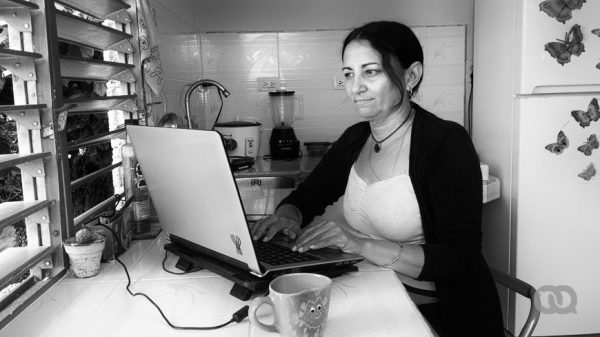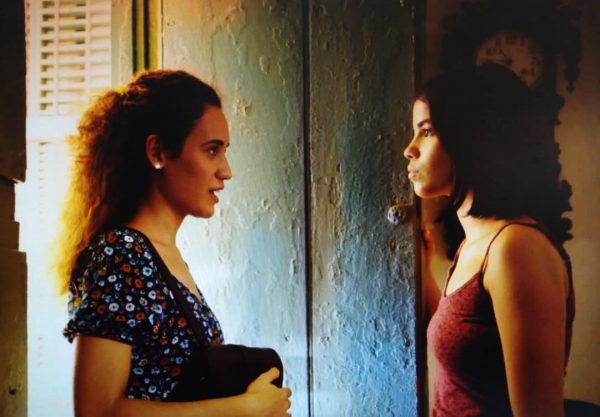Homosexual relationships have hijacked Cuban TV screens
HAVANA, Oct 26th (By Angel Marques) It speaks of the inclusive, modern and unprejudiced Cuba that is intended for the 21st century. However, Michelangelo’s influences have not yet arrived, in whose scenes of the final judgment – painted almost five centuries ago for the Vatican’s Sistine Chapel – ‘rude’ men appear embraced in a kiss.
Eroticism seems to have been hijacked from stories about homosexual relationships on Cuban TV screens.
Any hint is plucked away with shameful tweezers – or is left out even of the suggestions – in most cases, as a red line.
Excluding flesh, the characters are stricken by a deficit of humanity. Modesty, in this case, becomes insolent. It offends. Its extension to the homosexual condition itself is inevitable. Second offence.
Last February, Cuban Television edited out the kissing scene between two boys in the US film Love, Simon. The film was aired in the space “Pensando en 3D” (Thinking in 3D) – dedicated to youth audiences on Saturday afternoons.
The social networks exploded. There were harsh reproaches and also voices in favour of censorship. Finally, the channel apologized and reprogrammed the film in its original version.
“Representing a kiss, a simple kiss, was ruled out from the first proposal”, says the scriptwriter Olga Montes.
I knew the proposal could be daring
Olga Montes (Artemisa, 1973) is the author of an appreciated collection of books in the field of children’s and young people’s literature. She refers to the script of Luna Mia, a teleplay written by her about the tortuous romance between two high school girls, shown this summer on the Cubavisión channel.
“I knew that the proposal could be daring,” the writer told us, via email. She was facing a television production without previous experience and many suspicions.
“As far as I know, the times that homosexuality had been shown on Cuban audiovisuals, it was always represented by male characters or through adult women.”
After the film, Fresa y Chocolate (1993) opened a gap in the early nineties to place homosexuality and its repressive environments in the social discussion – institutional and civil -, the issue has been creeping through the thick walls of the Cuban media framework.
The cinema footsteps of the pioneer Gutierrez Alea were followed by the films: Chamaco (2010), Verde Verde (2012), Vestido de novia (2014), Fátima or Parque de la Fraternidad (2015) and more recently, Why do my friends cry? (2018) and Insumisas (2018).
The same has happened on television. However, The other face (2000), Here we are (2010) and Under the same sun (2011), were series and soap operas in which female homosexuality – designed by men – often “projects stereotypes”, said Montes who has several literary awards in Cuba and abroad.
Despite very few exceptions, “lesbian women are not usually protagonists in Cuban productions. Even less if they are young adolescents who are beginning to build their sexual identity,” noted Montes.
Beyond the prohibition of kissing girls on screen, “the proposal was very well received from the first moment I presented it to the ICRT youth group. I don’t think there was ever a but,” acknowledges the writer.

The scriptwriter of “Luna Mia”, Olga Montes (Artemisa, 1973).
Where did you look for the origin of Luna Mia (My moon)? Is it your story or did you write it expressly for television?
There are precedents in my literary work in which lesbian women are also protagonists. These can be found in the storybooks Galería de sombra (2012) and Naked in front of the mirror (2018) —both published by Editorial Unicornio. Yet the stories that are told are perhaps also from other perspectives.
What truths were meant to be detected in your television story?
I wanted to visualize the complexities that two girls who fall in love have to face and fight to defend their right to freely love each other. Friends, family, their own prejudices, which are the result of an education developed in a society that, despite all good intentions, still responds to a patriarchal and heterosexist system, in which homophobia and intolerance persist.
I wanted to highlight the process of coming out of the closet for two teenagers, in that very complex stage of life in which their own identity is being built and in which everything can be much more confusing and, therefore, difficult and even devastating.
In the case of female homosexuality, social hostility wields a double standard of discrimination…
Of course… The lesbian woman has had to overcome her condition as a woman and, also, for daring to love a person of the same sex.
Some viewers note a lack of eroticism in Luna Mía. And here we return to the issue of the kiss… Was what we saw one thing and what you wrote another? Were there negotiation processes between the author and the director and beyond both?
From the initial proposal to the finished product there were changes and, yes, also negotiations between the director, Mariela Lopez, and me. However, the essence of the story always remained.
Cinema is perhaps much more permissive than television when it comes to depicting erotic scenes. And Luna mia was made for TV. I had to focus on the audience and the time slot when it was going to be shown. The intention was to tell how two teenage girls fall in love when they are just discovering their sexual inclinations.
The time that elapses between the appearance of this ambiguous feeling of attraction between them and the full awareness of what it meant for both of them did not have to be accompanied or preceded by any explicit sexual practices. Moreover, we didn’t think it was necessary to indulge in the construction of more erotic scenes.
The representation of homosexual relationships in the audiovisual media still causes controversy in Cuba today. They are shown, hidden or represented with a dose of appropriate moderation.
I can assume that writing or adapting a story for television about homosexual relationships in contemporary Cuba is an exercise which places the author in a few dilemmas. What were the dilemmas in your case?
I do my best not to censor myself when I write, although I understand that literature is freer when it comes to dealing with these issues. Television is different because it does not depend solely on a personal vision. Instead, it involves a whole group.
If television ignores the existence of certain people, be they heterosexual or homosexual – gay men or lesbian women – for example, it is exercising what is understood as symbolic violence against them. This absence of symbols, models or references, psychologically damages human beings. They do not find a referential model in which to recognize themselves. Although, apparently there is no direct rejection towards them. Television and society reaffirm each other.
When I write and construct a story, whether, for an audiovisual or literary medium, I try to be consistent with my convictions – to reflect my point of view. If necessary, I adopt a transgressive attitude so that the story reaches people – moves them and makes them think.

In Luna Mía, teenage lovers suffer rejection, disbelief and even scorn in their own interactive universes. From the family – in one of them, to their own classmates – a social group in which hormones tend to take precedence.
“If heterosexist concepts continue to be transmitted to the new generations, they will continue to respond as you say”, Olga Montes concedes.
She believes that lesbianism suffers from heteronormative contempt. “It is not admitted as something serious” and has been subjected to marketing within the porn industry. “An exclusive sexual fantasy for the enjoyment of men,” she defines.
If you look in the rear-view mirror of history, maybe ten years ago a story like Luna Mía would have found some closed doors in the corridors at Cuban TV. Today, the sensitivity on such matters of sexuality is more open to the options of representation and debate.
However, a rainbow Cuba, while possible, is still coming out of the closet. Albeit slowly.
With fierce rejection by broad sectors, religious and not, same-sex marriage or an updated Family Code are still polemic. Some scholars warn of a conservative force capable of twisting institutional agendas. This can block the evolution of justice and the rearrangements of public morals.
While Olga Montes sees recognizable advances in Cuba, they still lag far behind the more inclusive societies. “In many parts of the world, it has been a long time since same-sex marriage was accepted by law.
But Cuban society continues to be quite patriarchal and heterosexist. We could verify this recently when allowing same-sex marriage was under discussion. On a personal level, I was surprised by the intolerance that many acquaintances adopted towards the proposal.”
More than half a century ago, one of the great feminists in history, the French Simone de Beauvoir, launched the ingenious phrase that encapsulates the domination of patriarchy. She said: “The problem of women has always been a problem of men.”.
It’s a summary that Olga Montes does not amend, but she does expand on. “The problem of women is a problem for women who do not fight to defend their rights. They hope that men will solve their problems. The problem of women has always been a problem of macho men and women.”
After being shown on Cuban TV, Luna Mía could be born to the bookish world as a novel under the title “Shall we play escape”. It could be narrated via text messages and stored on a hard drive awaiting better times.
“I trust that some publisher interested in publishing it will appear and bring it to light,” says Montes, optimistically.